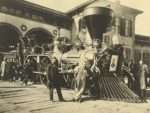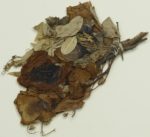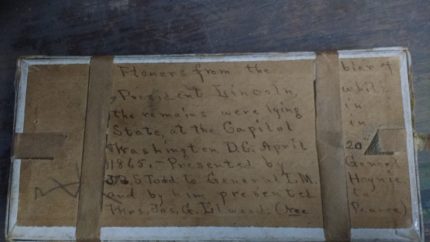A single delicate dried flower that lay on Abraham Lincoln’s bier has been discovered in the archives of a local historical society in Lockport, Illinois. Sandy Vasko, Director of the Will County Historical Museum & Research Center, discovered the single white rose last month while looking through some boxes stored in the attic. Beautifully preserved in a modest display case with a glass lid, the rose was identified by a handwritten label on the back as having performed the solemn duty of adorning the slain president’s coffin when it lay in state in the Capitol Rotunda in Washington, D.C., on April 20th, 1865. According to the label note, the rose was given to Lincoln’s good friend General Isham Haynie of Illinois who in turn gifted it Mrs. James G. Elwood of Joliet. James Elwood, was the mayor of Joliet and a Civil War veteran. Boxes of his belongings were donated to the Will County Historical Society decades ago. The rose and its all-important label was in one of them.
 There are very few extant pictures of the multiple funerals and public viewings of the coffin that were held along the long, slow, sad journey of Lincoln’s body from Washington, D.C. to Springfield, Illinois. This was deliberate. Secretary of Edwin Stanton, devastated by President Lincoln’s assassination was adamantly opposed to any hint of commercializing the horrific event. Grieving widow Mary Todd Lincoln agreed with him, and he ordered General Townsend, who was delegated to accompany the cortege, to prohibit all photographs. When he failed to do so in New York, Stanton was enraged and had every plate confiscated and destroyed.
There are very few extant pictures of the multiple funerals and public viewings of the coffin that were held along the long, slow, sad journey of Lincoln’s body from Washington, D.C. to Springfield, Illinois. This was deliberate. Secretary of Edwin Stanton, devastated by President Lincoln’s assassination was adamantly opposed to any hint of commercializing the horrific event. Grieving widow Mary Todd Lincoln agreed with him, and he ordered General Townsend, who was delegated to accompany the cortege, to prohibit all photographs. When he failed to do so in New York, Stanton was enraged and had every plate confiscated and destroyed.
 There is no picture of the Rotunda that shows the bier covered with flowers, only contemporary written sources describing the flowers, among them white roses. The flowers themselves are extremely rare. As far as we know, the only other ones are in the Ford’s Theatre National Historic Site in D.C., and it’s not clear whether they came from the funeral in the East Room of the White House, the one in the Rotunda, or from when he lay in state the next day. This find is historically significant because it’s such a rare survival, because of its involvement in an iconic tragedy in American history, and because it’s in Illinois, President Lincoln’s home state.
There is no picture of the Rotunda that shows the bier covered with flowers, only contemporary written sources describing the flowers, among them white roses. The flowers themselves are extremely rare. As far as we know, the only other ones are in the Ford’s Theatre National Historic Site in D.C., and it’s not clear whether they came from the funeral in the East Room of the White House, the one in the Rotunda, or from when he lay in state the next day. This find is historically significant because it’s such a rare survival, because of its involvement in an iconic tragedy in American history, and because it’s in Illinois, President Lincoln’s home state.
There is also no picture currently available of the rose itself. As you know, I am usually adamant about only writing stories if there are high resolution pictures available of the find. I have made rare exceptions, however, and this is most certainly worthy of one because the reason for there is no photo of the flower available is something I support unreservedly.
When I emailed the Will County Historical Society asking whether a photograph was available, I received a most gracious reply from Sandy Vasko explaining why they would not be releasing a photograph at this time nor do they plan to in the near future. The Will County Historical Society, like so many other small county and town historical organizations and museums, operates on a shoestring budget. They are staffed entirely by dedicated volunteers, including the director herself. The discovery of this one precious bloom might as well be King Tut’s treasure for the Society. It’s a unique opportunity for them to raise the funds they need to keep the lights on (and maybe even more importantly in the Illinois winter, the heat on) and invest in historic preservation projects that are pivotal to the county.
I am a great supporter of local historical societies, who almost always rely on volunteers and meager donations to preserve an area’s social history, genealogies, endangered structures and who are actively engaged in researching local matters that don’t get a great deal of attention from the outside. This is desperately needed work that keeps history alive.
In aid of these noble goals, on 4:00 PM February 17th, the flower will make its public debut at a special preview event that will include a buffet dinner, a silent auction and a speaker who will deliver a Lincoln-related talk. Tickets are $50 apiece and seating is limited to just 50 people, so if you are anywhere near there and want to see a single white rosebud that once rested inches away from the body of Abraham Lincoln, fill in this registration form (pdf) and mail it in with a quickness. People are already snapping them up even when they have to fly in from half the country away to attend. If you can’t attend, you can use the form to donate.
Sandy Vasko was kind enough to allow me to interview her about the find and the upcoming event. At the time when the James Elwood boxes were donated, the early 1970s, the Society was moving into a new (old, actually, but undergoing renovation) building. The 13 boxes of the Elwood collection were stashed in the building, nine in closets, four in the attic, and remained there for decades before Vasko started going through them this year.
On the bottom of the last box in the attic, she discovered the display case with the single white rose. When she read the label, she couldn’t even believe her eyes. She put it aside, walked outdoors in the 15 degree temperature to clear her head. When she returned and reread the label, it said the same thing she’d read before.
“For a museum director to find this kind of incredible artifact, it is so lucky,” Vasko said. “When I was touching it and handling it, it was like electricity. It was just so amazing.”
The flower is being kept under lock and key for its protection until the sneak preview next month. After that, it will return to the safe until it is displayed again in June. A Chicago artist’s drawing of the rose will be a give-away to one lucky attendee at the event. The museum staff is working on several ideas for postcards or saleable souvenirs that feature the rose drawing coupled with highlights from the label.
Speaking of which, it is one fantastic label, the kind of thing appraisers and historians always tell people to write on their heirlooms so future generations don’t wind up tossing random dried roses they know nothing about in the trash instead of preserving them like the sacred mementos they are. Vasko generously shared a photograph of the back of the box and its exemplary label with me. We can’t see the Lincoln rose yet, but we can see the only reason we know what it is.

I’m not Lincoln fan, but that is pretty cool 🙂
(Typo alert: you wrote ‘Secretary of Edwin Stanton’)
And of course I made a typo on my comment :/
Looks like the flowers were given to Gen. Haynie by Gen. J.B.S. Todd, the first cousin of Mary Lincoln.
Local historical societies are the unsung heroes. Managing the valuable artifacts that are often donated by those with local ties to the communities take a lot of time and money. Thanks for spreading the word!
There a small wreath of cedar and corn flowers hanging in the Civil War gallery of the Michigan History Museum in Lansing, MI. This wreath sat on Lincoln’s coffin during it’s time in Constitution Hall in Philadelphia in 1865.
Anything used to celebrate the death of a mass murderer like Lincoln should be preserved and adored.